Once More to the Lake
“In talking to others, I have come to believe that . . . some lonely spot, some private nook, some glen or streamside-scene impressed us so deeply that even today its memory recalls the mood of a lost enchantment.” So writes Edwin Way Teale, a mid-20th-century nature writer. For Teale, he can never return to those “lost woods of childhood.”
On this trip west to Oregon, I have returned to my “lost woods”: Dune Acres, a small community in the Indiana Dunes, nestled next to Lake Michigan. Dune Acres is where my father grew up, and where he set his third novel, At The Shores. His father built a cabin there at the height of the depression, and he grew up between sand dunes and backstroking out into Lake Michigan. Summers, we visited the grandparents. For me and my sister, the Dunes were pure fun: popsicles in the fridge, games of cut the pie and flashlight tag with the neighbor kids, and sleep outs in the dunes. To return to such a magic place is, of course impossible, because those childhood days of no cares are gone forever. But the place itself: it was there and I wanted to see the changes. Better still: old friends opened their doors.
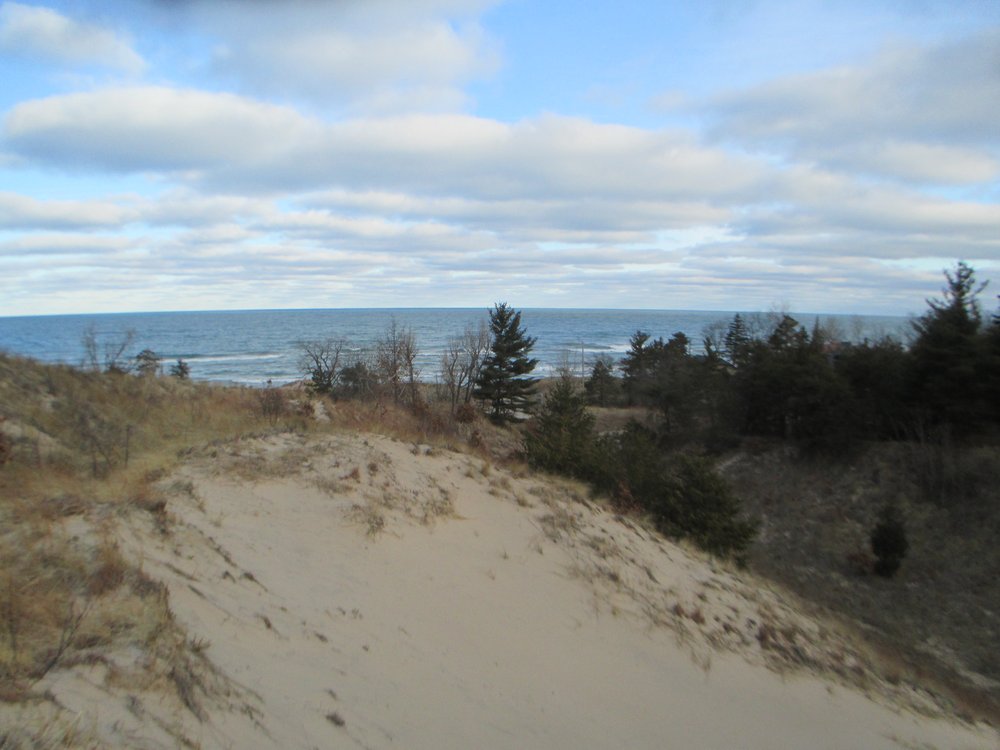
“In talking to others, I have come to believe that . . . some lonely spot, some private nook, some glen or streamside-scene impressed us so deeply that even today its memory recalls the mood of a lost enchantment.” So writes Edwin Way Teale, a mid-20th-century nature writer. For Teale, he can never return to those “lost woods of childhood.”
On this trip west to Oregon, I have returned to my “lost woods”: Dune Acres, a small community in the Indiana Dunes, nestled next to Lake Michigan. Dune Acres is where my father grew up, and where he set his third novel, At The Shores. His father built a cabin there at the height of the depression, and my father grew up between sand dunes and backstroking out into Lake Michigan. Summers, we visited the grandparents. For me and my sister, the Dunes were pure fun: popsicles in the fridge, games of cut the pie and flashlight tag with the neighbor kids, and sleep outs in the dunes. To return to such a magic place is, of course impossible, because those childhood days of no cares are gone forever. But the place itself: it was there and I wanted to see the changes. Better still: old friends opened their doors.
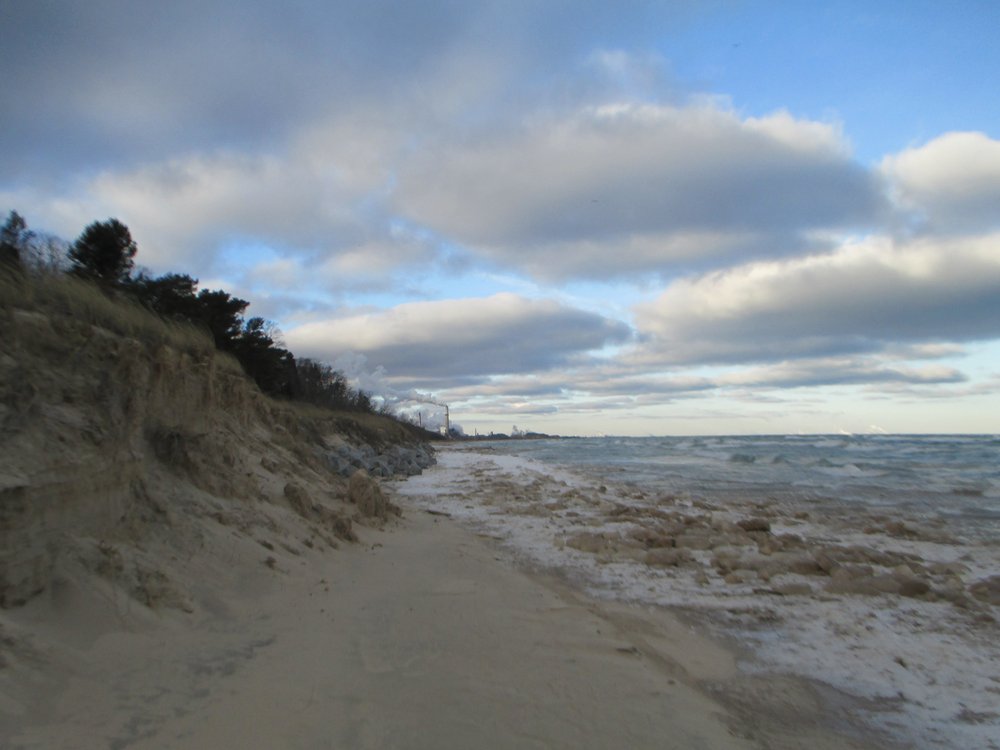
When I arrived, I crept down the main road that leads into the Dunes. My father used to pick up speed at this point, the roads his and familiar. We were tossed about in the back seat of the VB bug, then the Dodge Dart. But I wanted to savor the marsh before the woods, the curve on to East Road, the uphill onto Circle Drive. But the driveway to my grandparent’s house: shorter and really not so steep, and the house itself half the size of my memory.
I stood on the porch of my friends’ house, looking out on the wind tossed lake, white caps formed as waves rolled in. The lake extended to the horizon--I keep wanting to call it the ocean--and there met a pink, blue gray sky, a bank of clouds. The water was a gray green with a lighter green swatch far out. That always meant a sandbar, and when we were kids we used to swim or wade out, standing knee-deep a hundred yards into the water.
To the west and south, I saw the sparkle of towering buildings in Chicago. A few Ring-billed Gulls floated like balloons in the gray gray sky. I turned into the house to find a half dozen beds to choose from, a puzzle half made. My friends had clearly recreated this house so that their children could live with the magic of sand and water. The enchantment is not gone. Maybe Teale is wrong, maybe once a place is enchanted it is so forever, can never be lost.
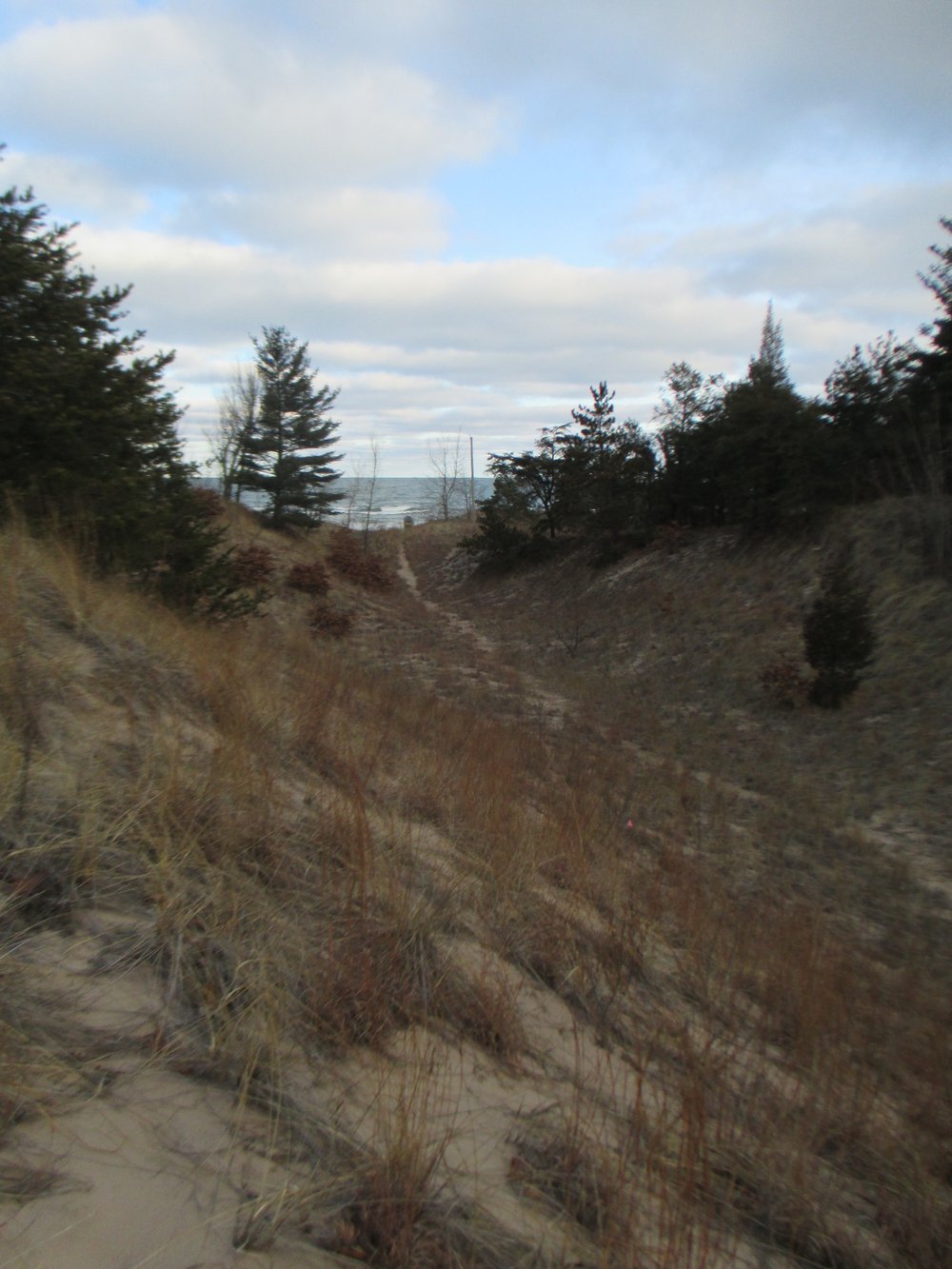
On the beach, ice formed, small balls encasing sand. In the summer there were alewives that piled up, marinating to a stink in the hot sand. All these years later, I still wonder what killed those fish? I looked down at the frozen sand, remembering searching for “Indian beads,” small stones hollowed out in the middle that we could string together in a necklace. Then I looked up and almost laughed: so close were the smokestacks of industry in Gary, just down the beach. Had I ignored them as a child, splashing in the docile waves of the lake? The blowout, the rolling sand dunes where we played our finest games, did not take a day to cross but twenty minutes, side stepping all of the native grasses that have come in to secure the sand. Ecologically this is a good thing but clearly no children play in these dunes anymore. New houses crowded the edge of the dunes. Maybe Teale is right, the lost woods are lost forever.
I spent the morning catching up and reminiscing with my friends--no time had passed, the wrinkles there but our laughter the same. Then I walked out the road, still narrow and sand dusted. There, heard the plaintive cry of a Red-shouldered Hawk perched high tree in a tree. I realized I did not have any bird song to accompany my memories, not the coo of Mourning Doves or the dee dee of the Chickadee. And so here was my Dunes music: the cry of a Red-shouldered Hawk. Delighted, I watched the bird as it flew toward the lake, wing beats steady, gracious, bold. Maybe we create and recreate our own enchantments.
Malheur is for the Birds
I love the word malheur, the way my neighbor in France sighs over the weather or a chicken that is ill: Quel Malheur. It’s impossible to translate the woe of the world, the adversity of life woven into those two words. Quel Malheur. But the Malheur in the news these days is the 187,000 acre Refuge in Eastern Oregon where a group of armed men are staked out, and not planning to leave.
In three days, I will slide into my Subaru wagon, loaded with skis and snowshoes, and head west, for Oregon. I’ve chosen a northerly route, through North Dakota and Montana, two states I have never visited. I’ll stop along the way, in search of northerly birds, hoping for such treats as a Great Gray Owl, but also less glamorous but still wondrous species for this Eastern girl, like Gray-crowned Rosy finch, or Evening Grosbeaks.
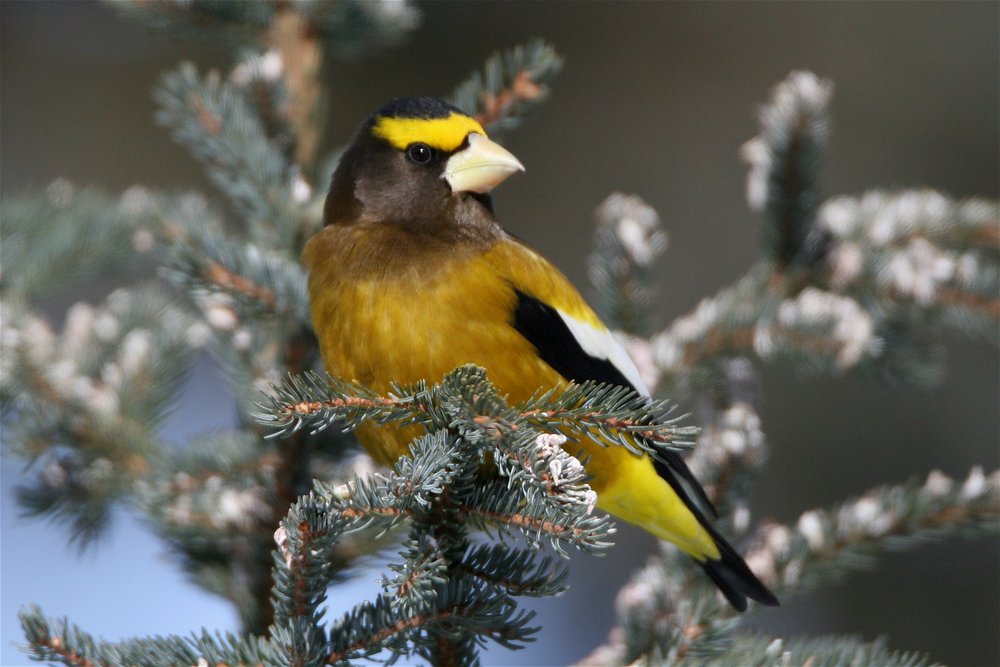
I love the word malheur, the way my neighbor in France sighs over the weather or a chicken that is ill: Quel Malheur. It’s impossible to translate the woe of the world, the adversity of life woven into those two words. Quel Malheur. But the Malheur in the news these days is the 187,000 acre Refuge in Eastern Oregon where a group of armed men are staked out, and not planning to leave.
In three days, I will slide into my Subaru wagon, loaded with skis and snowshoes, and head west, for Oregon. I’ve chosen a route through North Dakota and Montana, two states I have never visited. I’ll stop along the way, in search of northerly birds, hoping for such treats as a Great Gray Owl, but also less glamorous but still wondrous species for this Eastern girl, like Gray-crowned Rosy finch, or Evening Grosbeaks.
At the end of the journey I will be at Playa, a residency for artists and writers in Eastern Oregon. There, I intend to finish (ahem) writing my book, which chronicles the first two years of my bird-obsessed life. (Two chapters have been published online, here, and here.) I’m having a great time poking around in the past of bird watching history, learning about murders and murderers, adventures and misadventures, saints and sinners. The bird world is as complex and rich as any writer could hope for. Malheur certainly fits the definition of complex.
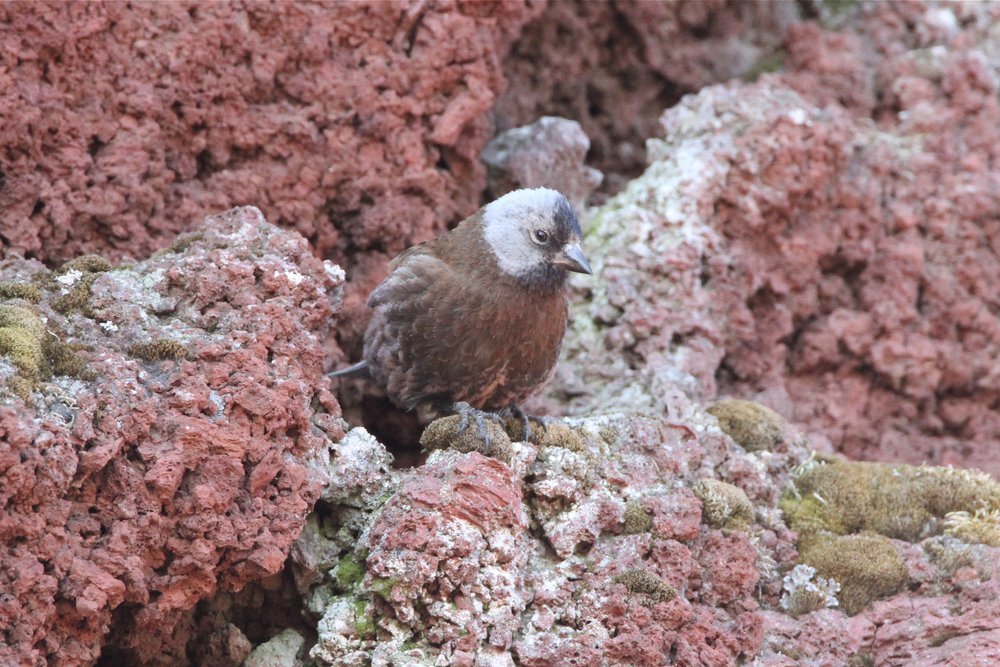
Malheur is not far from Playa, and I was hoping that it would be a stop on my route West, or a day trip away from writing. But the refuge is closed, the workers gone, many scared for themselves and their families. It is hard, for those of us in the East, to understand the Western relationship to land; the conflict between Dwight and Steven Hammond and the National Wildlife Preserve is decades old. So I don’t feel in any way qualified to speak on the situation—should these guys be in jail? I don’t know. What I do know, is that Ammon and Cliven Bundy have taken over the Refuge without support of locals, or the Hammonds. And, according to a writer in the National Law Journal, the standoff is legally untenable and many have written that the Bundy’s understanding of history and the constitution is poor at best. We all want them gone. More importantly: the birds want them gone.
The story that moved me is of the Malheur Field station director leaving the refuge (where birders and others can spend the night—the loss in revenue will be substantial). Before heading out, he spread seed for the wild Quail that count on him through the winter. What will happen to these and other birds, like the Great Horned Owls who have historically nested in the tower where the Bundy’s are staked out?
What I’m interested in is how birders—let’s call us a more peaceful group—have responded to this situation. Birders watch—and we are watching Malheur.
Renée Thompson, a birder and Oregon-based writer, has a terrific—that is historically based and reasonable—blog post on the history of the Refuge. Malheur was first protected in 1908 by Theodore Roosevelt (who created the first National Wildlife Refuge, Pelican Island off Florida in 1903, with a snap of the two fingers). The goal was to protect birds. So let’s remember that. But some birders are using the same inflamed language as those who have taken the land, issuing warnings and declarations of “we will get you.” Maybe this is the way to go: fight fire with fire (which is a bad joke, as the at the heart of this stand off is that the Hammonds started a backfire to stop a fire ignited by lightening).
Kenn Kaufman is tweeting on the subject while Andy Revkin in his dot earth blog post for the New York Times analyzes the solutions to the standoff and ends with the intriguing idea of flooding the refuge in the spring with birders. It’s great idea. And then there are suggestions that “old lady birders” (you know, those of us in floppy hats) should stage a sit in. Why not? Is it possible to organize the estimated millions of birders in this country to peacefully win this standoff?
Closed or not, I’m stopping at Malheur to see this land, home to over three hundred species of bird. And for now, what I have to say about the Bundy men taking over the Malheur National Wildlife Refuge: Quel Malheur.
A Small Difference
Ucross, Wyoming, population 25, is situated just east of the Bighorn Mountains, on the western edge of the Powder River Basin. It’s 20,000 acres of high desert sagebrush, rubbing up against wetlands, grasslands, and riparian habitat where the Clear and Piney Creeks run. It’s ranchland, dotted with cows and emptiness, studded with boulders tossed from space; there are pockets of petrified wood and lots of cool birds. And the news this fall is that all of this land is now designated an IBA— Important Bird Area—a designation made after careful review by the Audubon Society and the American Bird Conservancy. 20,000 acres of protected land where birds can breed or migrate through unmolested, is not much in the grand scheme of this planet. But for a few key species—the Greater Sage Grouse and the Long-billed Curlew —these 20,000 acres is a big difference, perhaps the difference of survival.
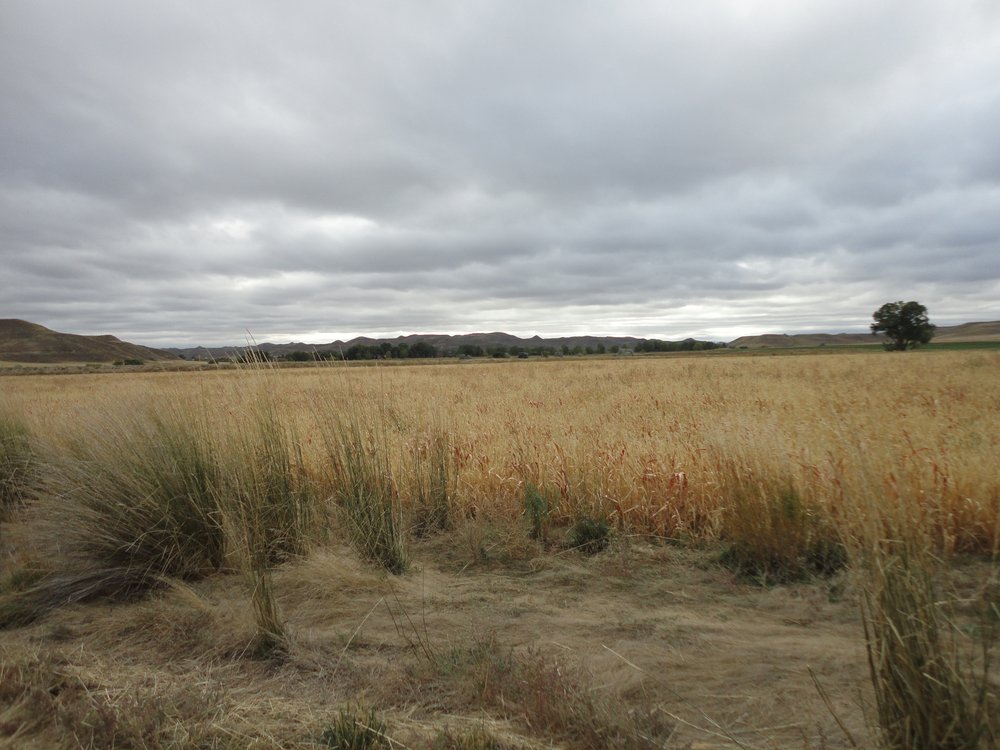
Ucross, Wyoming, population 25, is situated just east of the Bighorn Mountains, on the western edge of the Powder River Basin. It’s 20,000 acres of high desert sagebrush, rubbing up against wetlands, grasslands, and riparian habitat where the Clear and Piney Creeks run. It’s ranchland, dotted with cows and emptiness, studded with boulders tossed from space; there are pockets of petrified wood and lots of cool birds. And the news this fall is that all of this land is now designated an IBA— Important Bird Area—a designation made after careful review by the Audubon Society and the American Bird Conservancy. 20,000 acres of protected land where birds can breed or can stop on migration, is not much in the grand scheme of this planet. But for a few key species—the Greater Sage Grouse and the Long-billed Curlew —these 20,000 acres is a big difference.
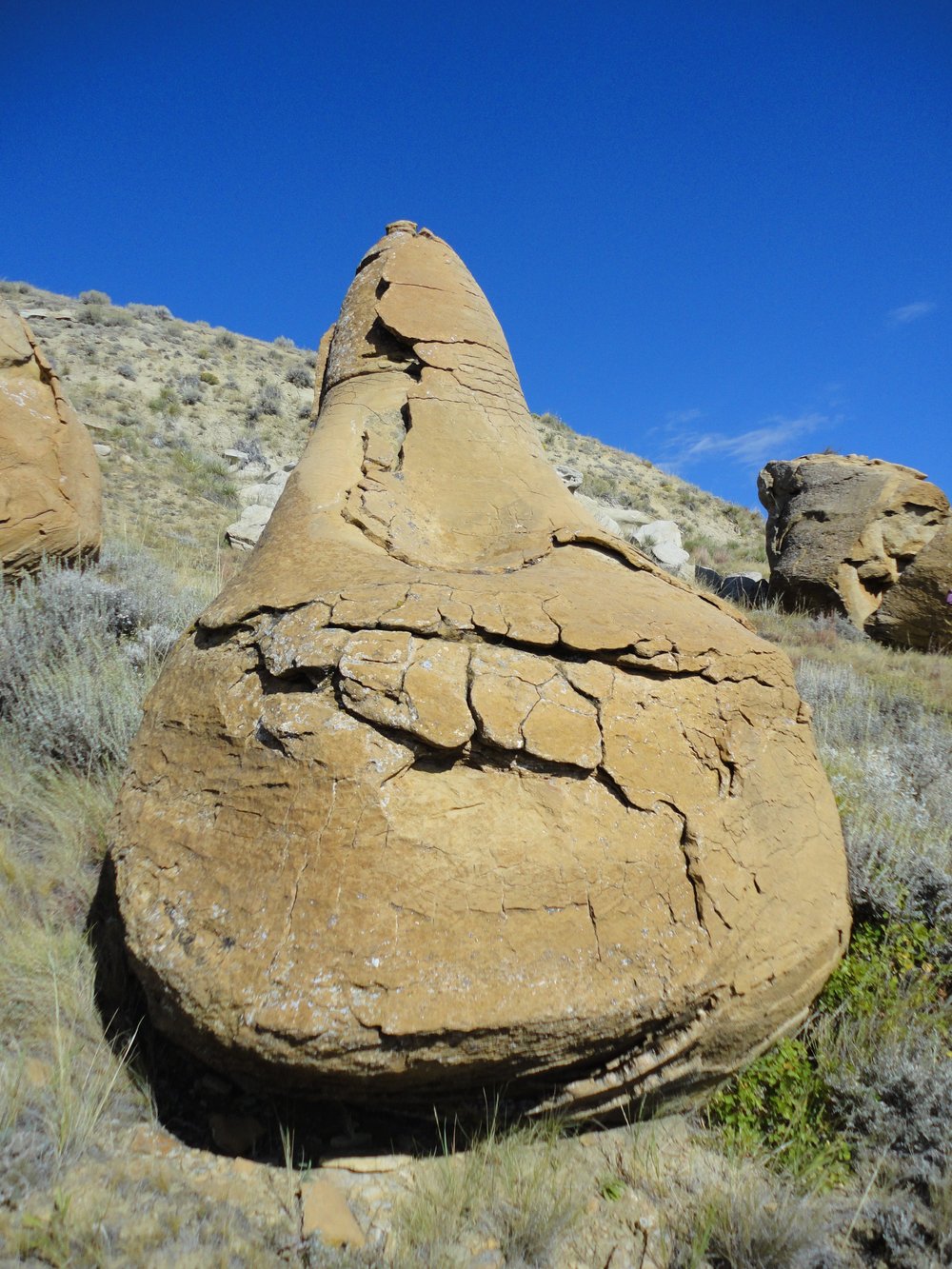
Fall of 2010 I had my first leave from teaching at Bard College and in that marvelous expanse of time, was able to finish my book, My Reach, while in residency at Ucross. Ucross isn’t a town—there’s no deli or saloon or even a post office. It’s really just the residency, run by energetic, smart people who have created their lives wedged between the vast empty silence of Wyoming and the busy neurosis of grateful creative people who flow through.
While at Ucross, I confess it was hard to push myself indoors to write in my clean, cosy cabin. There was so much outside that I wanted to see—the proghorn and rattlesnakes, but especially the birds. When I arrived, I was but four months into a bird-obsessed life (which continues without slackening). I hardly knew a sparrow from that Loggerhead Shrike but I was out every day getting to know my Vesper Sparrows and Townsend’s Solitaire. One evening I made a trip to a nearby reservoir and in front of my car strolled four birds that looked like goofy chickens with black bellies. Sage Grouse! The landscape I hiked and explored seemed to be filled with unexpected treasures. Soon enough, the Grouse vanished into the sage brush.
Ucross is the child of a visionary oil man from Minnesota, Raymond Plank, who bought the land and refurbished historic homes and schoolhouses to provide a place where artists and writers could realize their potential. Now, he’s providing land where birds can reach their full potential. He tells his story in his memoir, A Small Difference. His relationship to the land, both drilling for oil and protecting it, reveals the complexity of our relationship to land. These two things can co-exist. And it is exactly such moves of protection by Wyoming landowners that we are counting on to save the Greater Sage Grouse.

This fall, the Sage Grouse was under consideration for Endangered Species status. This was hotly debated because to protect the bird would mean to limit all kinds of activity on the land, especially drilling. Trying to avoid a blanket of restrictions that comes with the Endangered listing, landowners and conservation organizations have been working together—just like at Ucross—to provide habitat for the bird to breed. According to data compiled by the U.S. Fish and wildlife Service the species is doing well enough—a breeding population of 432,000— that it was not listed. Usually this failure to list would put me in a funk, but the work of Ucross makes me believe that “do it yourself” land protection might in fact work. I suspend my skepticism because Ucross, after all, is a place where an oilman believes in artists and in birds.
I know that some will remain skeptical that our government fell short. They may have. But Ucross—they’ve made a small difference. Let’s keep adding up those small differences all across the country. For birds. For all of us.


